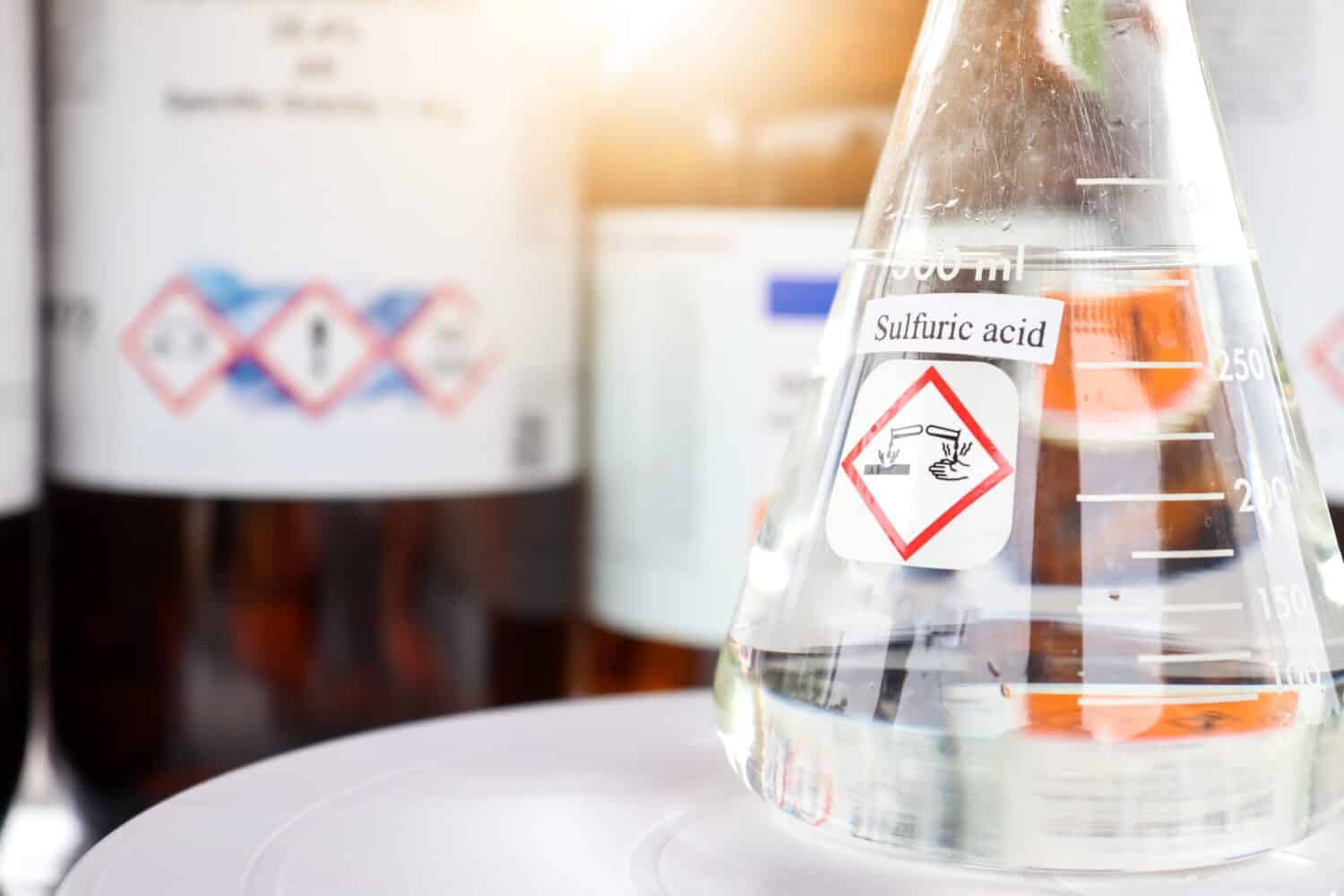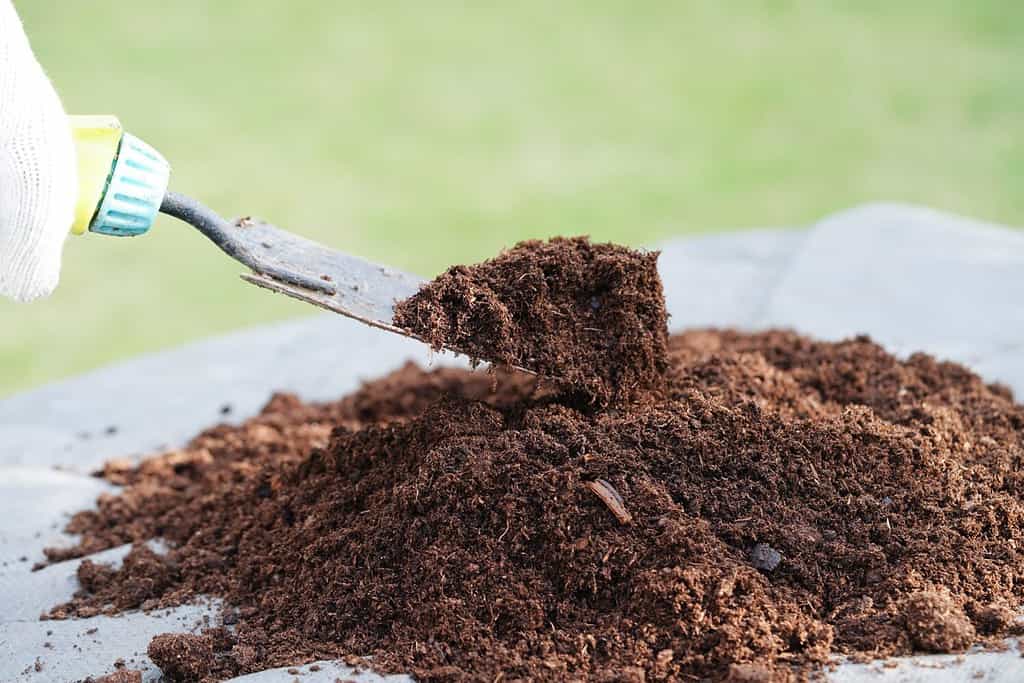Sulfuric acid symbolized as H2SO4, is a highly reactive chemical. This oily, usually colorless compound can do quite a bit. It’s a major component of acid rain, and industries rely on sulfuric acid for all sorts of uses, like making fertilizers and batteries. To truly grasp this compound’s many capabilities, you first need to grasp the concept of molar mass. Molar mass plays a major role in understanding the properties and behavior of substances like sulfuric acid. It refers to the mass of one mole of a substance and is expressed in grams per mole (g/mol). Follow along to learn all about the concept of molar mass and beyond.
Key Points Molar Mass of Sulfuric Acid
- Sulfuric acid (H2SO4) has a molar mass of approximately 98.08 grams per mole.
- Colorless and dense liquid
- Sulfuric acid has widespread industrial uses
- Acts as a potent oxidizer
- Sulfuric acid is crucial in extracting metals like copper, zinc, and nickel from ores through leaching.
Calculating the Molar Mass of Sulfuric Acid H2SO4

Sulfuric acid has a molar mass of about 98.09 grams per mole.
©chemical industry/Shutterstock.com
The molar mass of sulfuric acid is about 98.09 grams per mole. Sulfuric acid, represented by the formula H2SO4, comprises two hydroxy (OH) groups and two oxos (O) groups bonded to a central sulfur (S) atom. Using the atomic masses of hydrogen, sulfur, and oxygen, we calculate the molar mass of H2SO4 as follows:
The molar mass of H2SO4 = (2 * atomic mass of hydrogen) + (1 * atomic mass of sulfur) + (4 * atomic mass of oxygen), simplifying to approximately 98.08 g/mol.
Each hydrogen atom has an atomic mass of 1.01 grams per mole. Since sulfuric acid has two hydrogen atoms, you multiply 1.01 by 2. The sulfur atom has an atomic mass of 32.07 grams per mole. Each oxygen atom has an atomic mass of 16.00 grams per mole. There are four oxygen atoms in sulfuric acid, so you multiply 16.00 by 4. Add up the results. You’ll arrive at the molar mass of sulfuric acid, which is about 98.08 g/mol.
Real-World Applications of H2SO4

Volcanic activity is a natural source of sulfuric acid.
©Wirestock Creators/Shutterstock.com
One natural source of sulfuric acid is volcanic activity. During an eruption, large quantities of sulfur dioxide release into the atmosphere. Then the gas transforms into sulfuric acid in the presence of oxygen and moisture.
Hot Springs
Sulfuric acid is also a common element found in natural hot springs, like those in Yellowstone National Park, which has a lot of sulfur. This park sits right on top of a volcanic hotspot that heats rainwater that’s seeped deep into the earth. This water then mixes with volcanic gases like hydrogen sulfide and carbon dioxide as it moves through the ground.
Jupiter’s Moon: Europa
Sulfuric acid exists on Jupiter’s moon Europa. At first, the presence of sulfuric acid raised doubts about the possibility of life on Europa. But then some scientists brought up an interesting point. Sulfuric acid is an energy source for some organisms on Earth. So maybe it’s fueling some unknown space creature. This encouraged further exploration to investigate possible connections between sulfur oxidants on Europa’s surface and natural fuels produced from its hot interior.
One theory suggests that sulfur atoms originate from the volcanoes on Jupiter’s moon Io and are transported to Europa through the magnetic environment around Jupiter. Another theory suggests that sodium and magnesium sulfates from underground oceans on Europa’s surface are altered by intense radiation, forming sulfuric acid and other sulfur compounds.
Industrial Uses

Sulfuric acid is helpful in creating numerous fertilizers.
©sweet_tomato/Shutterstock.com
Because of its reactivity and water solubility, sulfuric acid plays a big role in many industries. For instance, it’s extensively used in the production of fertilizers, helping to enhance plant growth and improve crop yields. Sulfuric acid plays a crucial role in the production of phosphoric acid, ammonium phosphate fertilizers, superphosphates, and ammonium sulfate.
Metal Mining
Sulfuric acid is actually widely used in the mining and metallurgical industries. It’s a highly reactive substance that can dissolve metals and cause combustion in organic compounds. It plays a big role in extracting metals like copper, zinc, and nickel from their ores. They use a process called leaching, where sulfuric acid helps dissolve the metal ions from the ore. This makes it easier to separate and recover valuable metals.
Battery Production
Sulfuric acid is also a key component in the production of lead-acid batteries. These are the type of batteries for powering cars or back-up power supplies.
Ancient Art Techniques
Sulfuric acid has an artistic connection. Throughout history, artists have used sulfuric acid for different projects, like a technique called aquatint. Aquatint is a way to create different tones on a metal plate. The result is a print with richly textured areas and varying tones.
The Corrosive Nature of Sulfuric Acid and its Potential Hazards
When sulfuric acid meets metals, it sets off a reaction called corrosion. The acid rusts the metal by making it lose electrons and turn into metal ions. These metal ions then mix with the acid to create metal sulfates and hydrogen gas. For instance, when sulfuric acid reacts with iron, you get iron sulfate and hydrogen gas. The compound’s corrosive nature is one of the things that make it so dangerous to handle. The CDC warns that sulfuric acid can cause severe damage to the skin, eyes, teeth, and lungs, and in severe cases, it can be fatal.
Explosive Reactions
Sulfuric acid reacts explosively with alcohol or water, generating heat. When diluted with water, it reacts with metals to produce flammable hydrogen gas, creating an explosion risk.
Non-Combustible Oxidizer
Although sulfuric acid doesn’t burn, it acts as a potent oxidizer. It enhances the combustion of other substances, making it a dangerous compound in fires. The emission of toxic gases during fires adds to this hazard.
Acid Rain and Sulfuric Acid

Acid rain has a widespread impact, damaging structures and ecosystems.
©perfect strangers/Shutterstock.com
Sulfuric acid is a primary component of acid rain. When pollution mixes with raindrops in the atmosphere, it forms acid rain. There are also natural events that contribute to acid rain. For instance, sulfuric acid occurs naturally in the atmosphere after a forest fire or following volcanic activity. And despite its name, acid rain doesn’t contain acidic substances like battery acid.
Damaging Impact
Acid rain can cause damage to plants, animals, and buildings. The impact on ecosystems is often widespread. Acid rain, carried by winds, can travel great distances. Often waterways and lakes suffer the most severe impacts from acid rain storms. This is evident in the relationship between acid rain and phytoplankton. When acid rain reaches the lakes, it alters the pH of the water, which phytoplankton require for survival. Fish that rely on the plankton start dying, and the vicious cycle continues. As the phytoplankton population declines, the environment becomes increasingly hostile.
Acids With Similar Molar Mass
| Acid | Molar Mass (g/mol) |
|---|---|
| Nitric acid | 63.01 |
| Phosphoric acid | 97.99 |
| Carbonic acid | 62.03 |
| Acetic acid | 60.05 |
| Sulfurous acid | 82.07 |
The acid’s in the table above fall within the same weight category as sulfuric acid, but none weigh more. Sulfuric acid (H₂SO₄) has a higher molar mass compared to the acids listed at about 98.09 g/mol.
Final Thoughts on Molar Mass of Sulfuric Acid
Made up of hydrogen, sulfur, and oxygen atoms, sulfuric acid has a molar mass of about 98 grams per mole. Scientists study this weight to understand better the corrosive compound and how to interact safely. And now you know more about how this amazing substance operates. Sulfuric acid is a fascinating compound used in fertilizers, battery production, and beyond. What else should you know? Keep exploring other elements and compounds to learn even more.
Thank you for reading! Have some feedback for us? Contact the AZ Animals editorial team.







